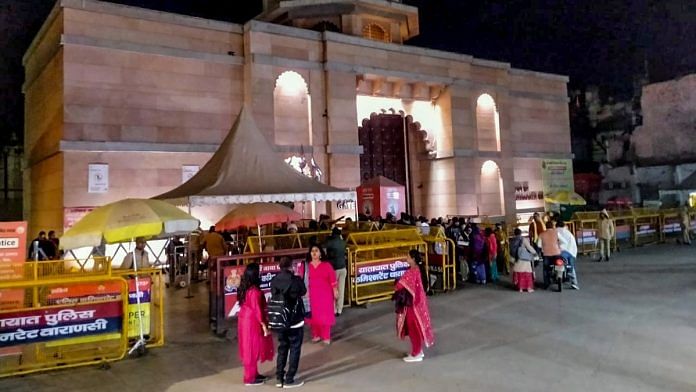Varanasi: One of the main reasons the city administration in Varanasi facilitated puja in the southern cellar of the Gyanvapi structure within hours of the district court permitting it was that the legal status of the deities is that of a minor, and a minor could not be left “hungry” for too long, ThePrint has learnt. Idols placed in the cellar include those of Hindu deities “Hanuman”, “Vishnu”, “Ganesh”, “Makara”, among others.
According to sources in the Uttar Pradesh government, Shailendra Pathak, on whose petition the Varanasi court passed the order Wednesday, approached officials immediately after the judgment requesting them to allow the puja as soon as possible, since the deity was a minor and needed to be “fed”.
A day before he was to retire, Ajaya Krishna Vishvesha in his capacity as a judge of the Varanasi district court directed the administration to make the arrangements for puja and raag bhog, which can roughly be translated as “feeding” the deity, done by a priest designated by the plaintiff and Shri Kashi Vishwanath Temple Trust.
When approached for comment, District Magistrate S. Rajalingam, who has been appointed as the receiver or custodian of the southern cellar of the Gyanvapi complex where the puja was conducted, only said: “The orders of the court were complied with.”
However, sources in the administration told ThePrint that there were a number of factors that led the administration to comply with the orders overnight. Pathak’s plea to conduct the raag bhog for the deity was one. There was also a concern that if the deity is kept “hungry” for too long, it could lead to resentment or anger among Hindu devotees.
Moreover, it was felt that it would be a “law and order nightmare” to conduct the puja in the daytime, when the Gyanvapi complex is surrounded by over a lakh devotees on a daily basis, and it would be difficult for the administration to control the situation if even a handful of devotees started raising slogans. The administration, said sources in the know, also wanted to complete the puja well before the Friday prayers were offered in the mosque since that too could lead to a law-and-order crisis.
The Muslim side in the case before the Varanasi court criticised the city administration for exhibiting “unnecessary haste” in executing the orders of the district court. “The court had said their order should be executed in seven days, they did not even give us seven hours,” Syed Mohammed Yasin, joint secretary of the Anjuman Intezamia Masjid Committee, told ThePrint. “What was the need to do all this overnight, and that too surreptitiously?”
Yasin and Mufti-e-Banaras Maulana Abdul Batin Nomani, secretary of the Anjuman Intezamia Masjid Committee, said they tried calling the district magistrate that night, but their calls went unanswered.
Sources in the administration said after the court delivered its judgment Wednesday afternoon, they immediately swung into action and got in touch with the petitioner and the Shri Kashi Vishwanath Temple Trust. Within a few hours of elaborate deliberations with senior police officers, it was decided that the puja would be performed the same night.
The police forces were immediately mobilised, and by 6-7 pm, there was “elaborate deployment” of forces in Muslim-dominated areas to avert any untoward incident, said sources in the security establishment. There was also a conscious decision taken to keep the media away from the temple-mosque complex while the puja was conducted.
The Public Works Department (PWD) was roped in to cut off the pillars of the iron barricade in front of the fourth (southern) cellar, where the puja was to be conducted. The Gyanvapi structure was barricaded with iron fences in 1993 by the Mulayam Singh-led Samajwadi Party (SP) government to protect the structure from damage or vandalism in the aftermath of the Babri demolition in Ayodhya in 1992.
Hindu petitioners have claimed that they had been offering prayers in the fourth cellar or what is known as “Vyas ji ka tekhana” until access to it was stopped by the Mulayam Singh government. The iron barricades leading up to the tekhana were removed, and an iron gate placed in their place. The priest who conducted the puja was brought by the petitioner and the temple trust, and about eight idols were placed inside the cellar at night.
The idols, sources said, were recovered from the same spot during the scientific survey conducted by the Archeological Survey of India (ASI) last year, and were already in the custody of the district magistrate.
(Edited by Amrtansh Arora)



